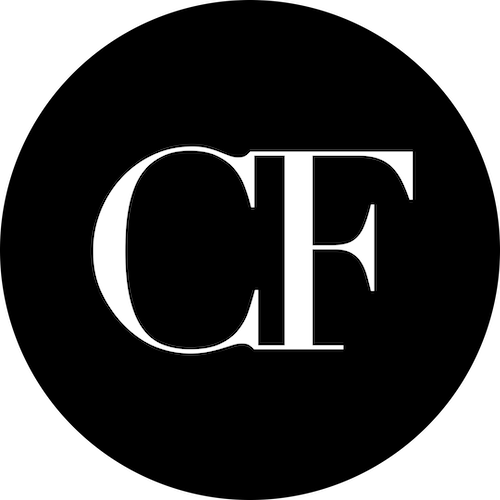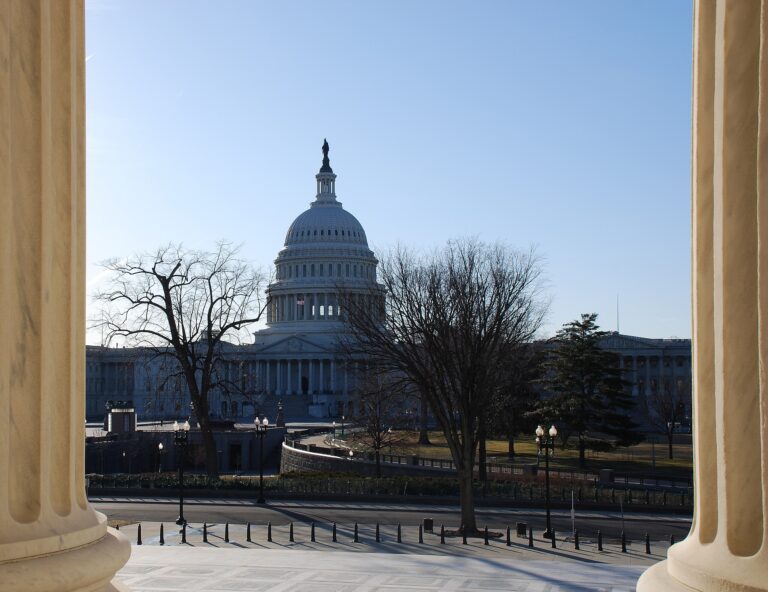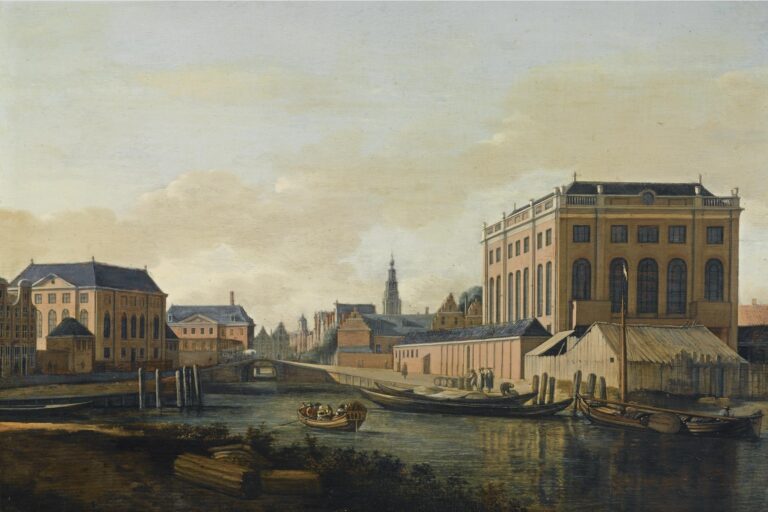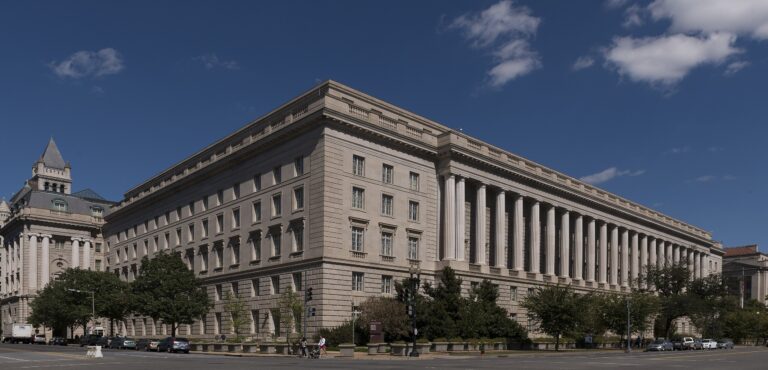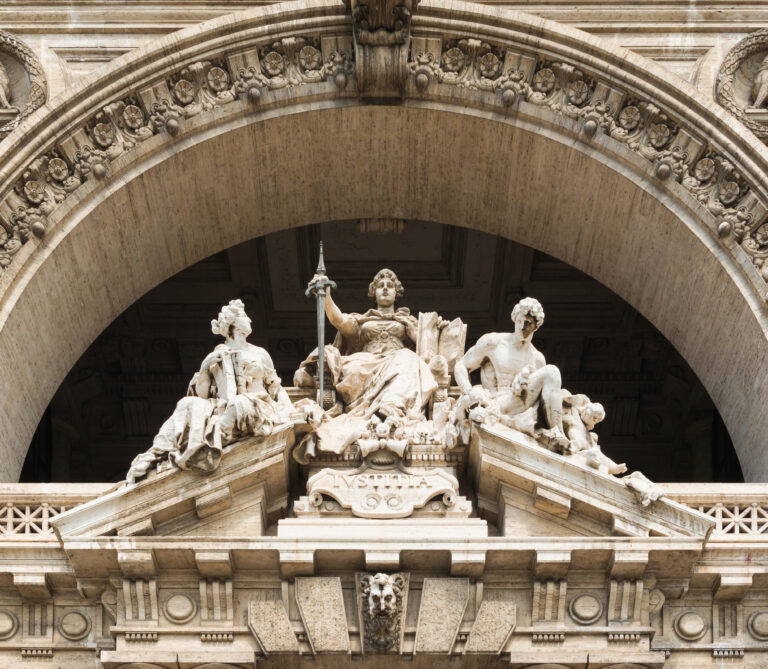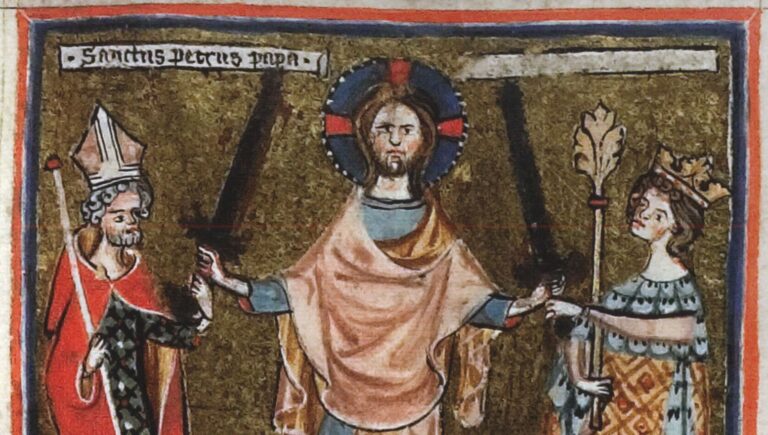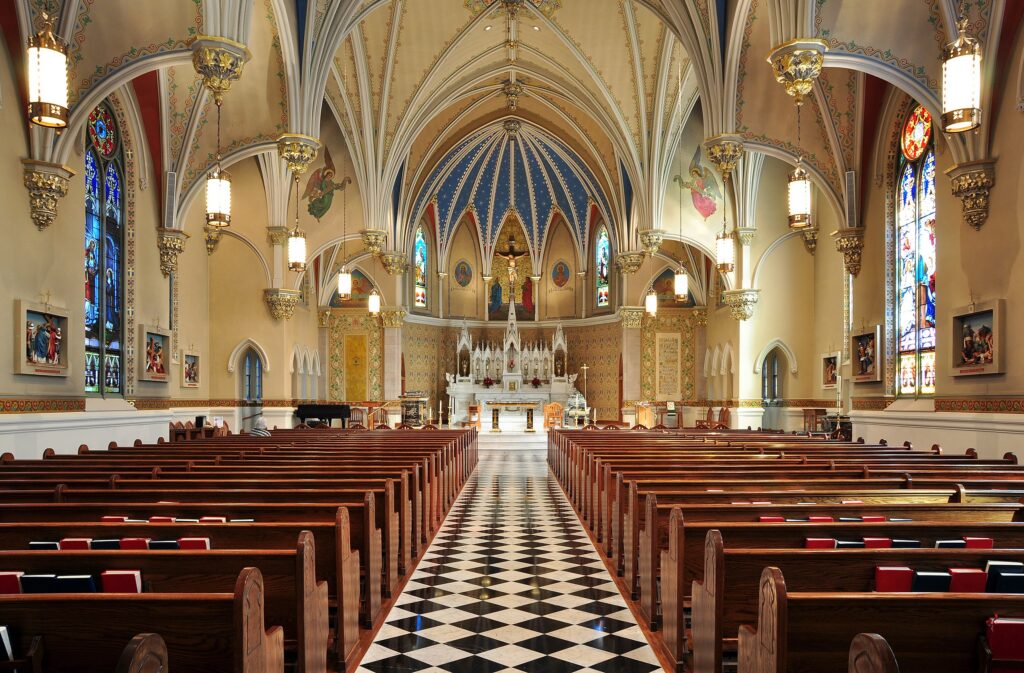
Catholic Social Teaching and Agnosticism about Democracy in the US Church
Massimo Faggioli
St. Andrew’s Catholic Church in Roanoke, Virginia by Joe Ravi (CC-BY-SA 3.0).
With the election of Leo XIV, who chose his name in an acknowledgment of Leo XIII, the pope of Rerum Novarum, Catholic Social Teaching (CST) might be back in an even stronger way. Hence, there were great expectations for the apostolic exhortation, Dilexi te (On the Love for the Poor), that Pope Leo published on October 9, 2025. The emphasis on social justice Catholicism has continued since Vatican II–and for U.S. Catholicism, in particular, since its reception during the pontificates of John Paul II, Benedict XVI, and Francis. But it is a complicated story, especially today, for U.S. Catholicism and for the nation. The assumption of CST as the definitive test of the church’s impact on the contemporary world could be more a problem than a solution in our contemporary global crisis of democracy.
CST became the most important doctrinal development for the encounter between Catholicism and political modernity in the nineteenth and twentieth centuries, especially in the century of the great migration of Catholics to the United States. Catholics in the U.S. had to overcome the fears that these outsiders of an immigrant Church, allegedly puppet-mastered by a foreign leader in the Vatican, would take over a Protestant country. It was a time when Catholic– Irish, Italians, and others who were still in the cultural “ghetto”–did not yet fully qualify as “white” and therefore were not seen as real Americans. The election of the first Catholic president in 1960 and the teaching of the Second Vatican Council liberated Catholics from the “finger of suspicion” that President John F. Kennedy mentioned in his famous campaign speech in Houston in September 1960. CST was developing as part of the growth of, and contribution to, the American democracy and to the democratic ethos of Catholics worldwide, beginning with Europe.
In these last hundred years, and especially after World War II and the Cold War, U.S. Catholics (especially white Catholics) have become the ultimate insiders in America. They no longer must prove themselves in the eyes of what used to be the mainstream – Protestant Christianity and the liberal establishment. That acceptance happened thanks to a process of convergence, in the political orientation of Catholics, between the Church’s social doctrine and the liberal political order. This happened especially thanks to Vatican II, but also thanks to the centripetal forces of the Cold War, anti-Communism, a booming economy–in short, thanks to the successes of the “American century.”
Today, in the second Trump presidency, we do not know whether U.S. Catholicism will make a difference in changing the direction the nation seems to have taken. Part of the problem is that the language of CST is alive and well, especially when it comes to migrants and refugees. But a Catholic public argument in defense of democracy is hard to find. This is remarkable given what happened in the U.S. in the last few years and what is happening today. It is also a notable difference from the public positions taken by other Catholic bishops’ conferences in Europe on the issue of democracy in the last few years, for example in Germany and in France.
In November 2024, Donald Trump was elected U.S. president for the second time. Trump’s vice president, JD Vance, has become the most powerful Catholic in the country, the second in command to a man who would be 82 at the end of his second four-year term. Vance has been chosen by a man who after losing the election of November 2020 did not hesitate to call for violence for overturning its result. JD Vance repeatedly brushed aside and dismissed what happened between November 2020 and the assault against Capitol Hill on January 6, 2021.
Those acts put the U.S. in the category of those countries where it is not taken for granted that there will be a peaceful transition of power from one president and one party to another. The symbolic violence of impolite and profane speech of populist leaders often sets the stage for physical violence. In Trump’s America, we are already beyond that point. The symbolic and rhetorical violence against the ideological internal enemies has already become violence against the democratic system, especially the separation of powers.
What does this have to do with CST? Vice President Vance cloaks his anti-immigrant rhetoric and politics in a “traditional” social Catholic fashion. A case in point is the debate sparked by Vance’s remarks on immigration and the ordo amoris at the beginning of the second Trump presidency, and near the end of Francis’ pontificate. JD Vance’s remarks on how his interpretation of ordo amoris shapes his views on immigration prompted Pope Francis to publish what amounts to a political testament from his pontificate in his February 10 letter to the U.S. bishops. As it turned out, Vance met Francis on the last full day of the Argentine pope’s life.
U.S. Catholicism finds itself in a deep relationship with the democratic and constitutional system. It’s a church that embraced both constitutional democracy and religious freedom, and also taught the rest of the global Church about it at the Second Vatican Council. But for all their emphasis on CST, one would look in vain for statements from the U.S. Conference of Catholic Bishops (USCCB) about the preference of Catholic teaching for democratic and constitutional systems over authoritarianism, or for the rule of law over threats to prosecute and jail political opponents.
The silence of the U.S. bishops about democracy is part of an epochal transition within U.S. Catholicism. The American Catholic political culture of the generation of Catholic politicians like Joe Biden and Nancy Pelosi has been substituted by a different version of Catholicism that is non-committal, or worse, when it comes to democratic and constitutional values. This new, subversive Catholic political elite claims to be “social”–through its appeal to the forgotten, common man–in a way that wants to be seen in line with CST.
This alignment has new features: the alliance between the self-portrayed social awareness of a convert to Catholicism like JD Vance and the new para-religious projects of Peter Thiel, self-styled as a follower of Rene Girard, is something really difficult to explain to European Catholics. And there are other things not new in Catholic history to which European Catholics are actually more alert, compared to Americans. Already at the end of the nineteenth and the beginning of the twentieth century, deep connections in Europe–Italy, France, Germany and Austria esepecially–between social Catholicism, nationalistic populism (“Völkischer Nationalismus”), and antisemitic, nativist politics of what later became fascism and Nazism.
The almost exclusive emphasis of American Catholics on CST was already noticed by eminent thinkers who had found refuge in the U.S. during the fascisms of the last century. Fr. Luigi Sturzo, the founder of the Popular Party in Italy, who fled to the U.S. during Mussolini’s regime, had already noticed the reluctance of American Catholics to take a position against fascism. More than a problem of personal relations between Sturzo and the American Catholic clergy, one can see clearly important differences between Sturzo and Fr. John Ryan–and even more between Sturzo and Fr. Charles Coughlin–on the question of democracy and fascism, and the role of the Church in confronting fascism.
The trajectories of the twenty-first-century church in the U.S. demonstrate that “social Catholicism” and the democratic, constitutional culture of Catholicism are two different things, and that an emphasis on CST can become an easy way out if CST is articulated in the absence of a discourse on constitutional democracy. The political history of Catholics in Europe and the West is full of politically committed social Catholics who embraced authoritarianism–fascism, Nazism, Francoism, and so on–while pretending to defend a traditional idea of society, of the family, and of religion.
Some of the early twentieth-century problems in the relations between the culture of the American Catholic clergy about democracy and CST are still here in the twenty-first century–only worse. The problem is that in the current phase of “de-culturation” of Catholicism, what was once a cautious illiteracy about democracy has become, at best, a deliberate agnosticism about democracy that falls easily into the hands of the American ideologues of illiberal and anti-liberal Catholicism and feeds an indifference towards the rule of law and an ordered system of government. For the survival of American democracy, but also of American Catholicism, it is important for both progressive and conservative Catholics to clear up the ambiguities of the emphasis on Catholic social teaching.
The 2024 presidential election was a soul-searching moment for U.S. Catholicism. We know what happened in the elections, and what has been happening in America since. American Catholics must explain their role in what the U.S. has become. Gone are the days when only White Evangelicals, or Wall Street, or the military-industrial complex could be blamed for the decline of American democracy. Both clergy and lay leaders of U.S. Catholicism must make a choice about which political system they think is more compatible–or just less incompatible–with the values of the Gospel. This choice has not been made yet by those who officially represent the Catholic Church in the U.S. The consequences are not abstract: upholding the rule of law, the respect of minorities in a pluralistic and multicultural society, the protection of voting rights, and the rejection of ideologies of nationalist and racial supremacy.
In the long run, we will see the effects of these cultural and ideological mutations within the U.S. Church on global Catholicism. Remaining loyal and committed to the democratic ideals used to be a key credential for American Catholics. The threat to our democratic institutions that we are seeing today, has been in part also a betrayal of those credentials as well as those who need to be able to have faith in Catholics and the Church.
The election of Leo XIV to the papacy could be a turning point in the awareness of U.S. Catholics on these issues, as long as we are clear on the differences between Leo XIII and the intransigent roots of nineteenth-century “social Catholicism” on one side and today’s twenty-first century world on the other. In this moment that some see as a neo-Thomist “Leonine revival,” it would be important to rediscover the critique of a certain social ideology surrounding the emphasis on the “social doctrine of the Church” of a Thomist thinker like Marie-Dominique Chenu. This is probably one of the aspects of Chenu’s thought that finds a difficult reception in Anglo-American Catholicism and in the neo-Thomist revival today. An important recent book by Mary Kate Holman, a young American scholar of Chenu, has the potential to change this conversation.
I am looking forward to Leo XIV’s message on Catholic social doctrine, now more than ever. But the disagreement between different kinds of Catholics–and, more generally, among Christians–in the public square today has escalated, from the early stages of the culture wars, when it was a lack of consensus on social policies or hot-button issues. It has become something much more fundamental. Without an emphasis by Church leaders on the importance of constitutional democracy, on political freedoms, their discourse and work for social Catholicism could be fatal to the very values the Catholic social doctrine wants to uphold. This is important not just ad intra. Ecumenism, interreligious dialogue, religious freedom for the Church–all this needs to rely on a certain basis of political democratic and constitutional consensus that “social Catholicism” alone cannot provide.♦
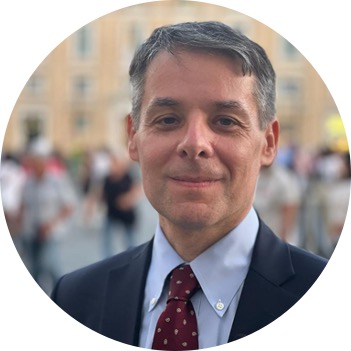
Massimo Faggioli is professor in ecclesiology at the Loyola Institute at Trinity College Dublin (Ireland). Between 2016 and 2025 he was professor in the Department of Theology and Religious Studies at Villanova University (Philadelphia, USA). He is co-author of Global Catholicism: Between Disruption and Encounter (2024) with Bryan Froehle, with whom he co-founded and co-edits the series “Studies in Global Catholicism” for Brill Publishers.
Recommended Citation
Faggioli, Massimo. “Catholic Social Teaching and Agnosticism about Democracy in the US Church.” Canopy Forum, October 18, 2025. https://canopyforum.org/2025/10/18/catholic-social-teaching-and-agnosticism-about-democracy-in-the-us-church/.
Recent Posts

